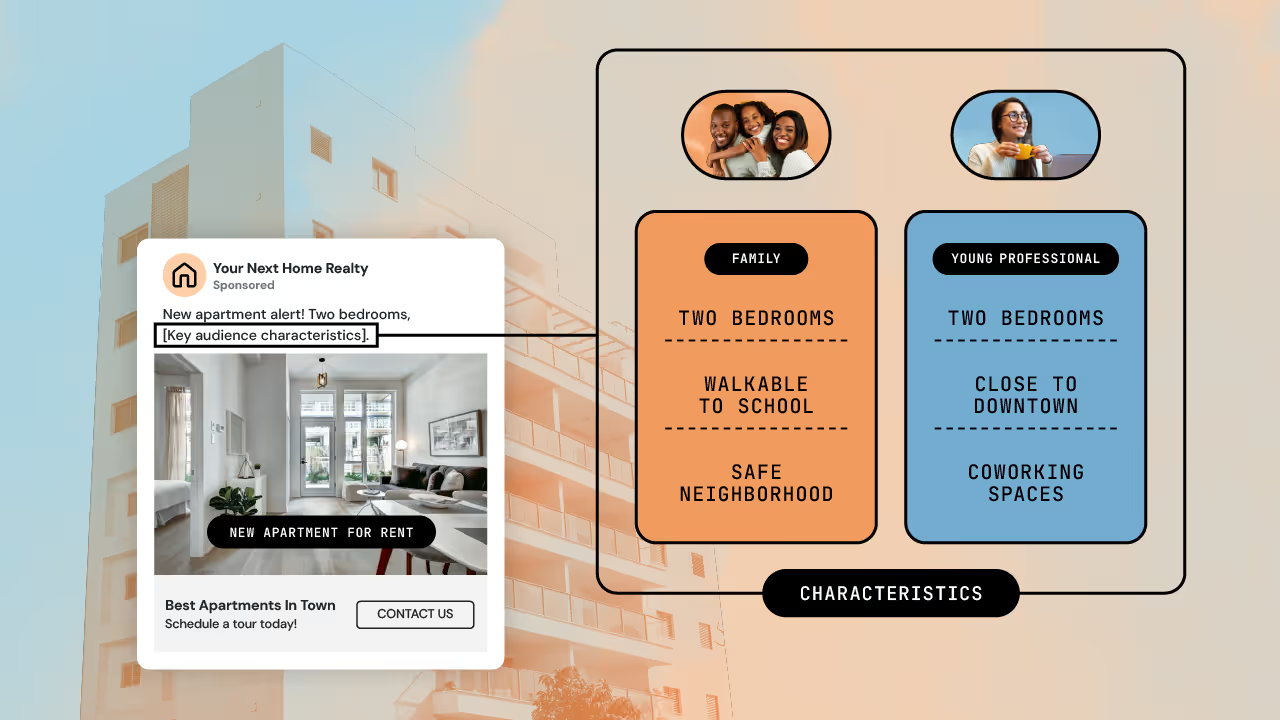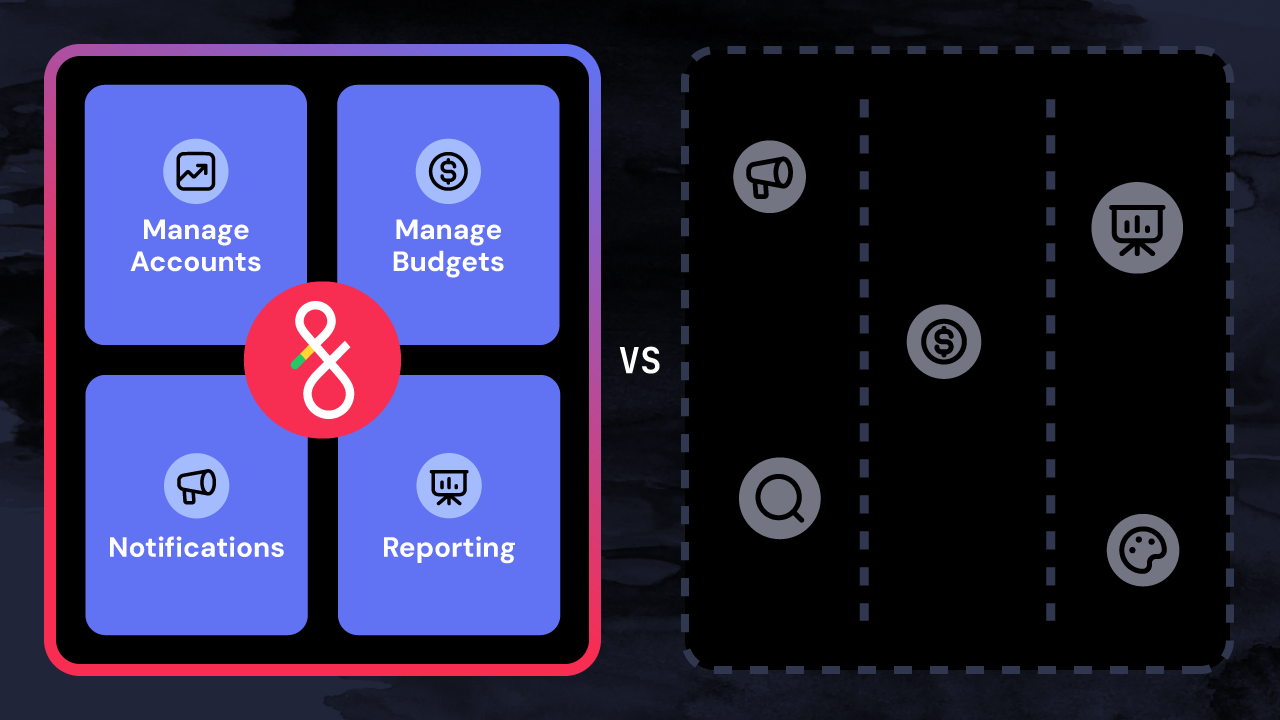For multifamily advertisers, vacancies are more than just empty units: they’re lost revenue. Vacancies also consistently pressure ad teams when leases turn over, since keeping vacancies low is directly tied to stable revenue and maintaining high property valuation.
But what if you could adopt a proactive multifamily advertising strategy instead of constantly reacting to immediate vacancy needs? Automation can help you do more with a lot less time and effort, like swapping out campaigns based on 60-day occupancy rates or reallocating budgets based on real-time performance.
Here are four advanced, automation-powered strategies that streamline your ad operations while helping you hit your goals.
Minimize vacancies with automated workflows triggered by occupancy forecasts
High occupancy rates are the cornerstone of financial stability and growth for multifamily properties. The longer a unit sits vacant, the harder it is to make up lost revenue.
Many multifamily advertisers use a 60-day occupancy rate as a predictive indicator of vacancies. This metric refers to the percentage of units occupied in a building within a rolling 60-day period based on lease renewals, expirations, and new tenants.
The 60-day occupancy rate is a helpful metric when determining what kind of advertising strategies you should run for a given property. For example:
- If occupancy rates suggest a high likelihood of turnover in the next two months, you can focus on reengaging current residents to renew their leases. Keeping existing renters in place can reduce churn costs.
- If vacancies are projected to rise, perhaps due to new units coming online, you can shift more budget to campaigns targeting prospective tenants. This ensures units are filled without sitting empty.
Odds are, you have your own advertising strategies based on specific occupancy rates or trends. Even though you know what to do, you have to activate these ad strategies manually. Moving budgets between different campaign types, updating promotional specials and promotions, or changing targeting variables takes a lot of time—especially if you’re running property-specific ads on multiple channels.
Automated workflows take the guesswork (and legwork) out of this process by automatically activating specific aspects of your campaign strategy based on occupancy data.
For example, tools like Fluency Blueprints can adjust campaign components automatically based on your agency’s “rules” about how to react to forward-looking occupancy data. This could include adjusting bidding strategies, swapping in different ad copy, or changing audience parameters.
BH Management, the eighth largest multifamily management company in the nation, exemplifies what this strategy looks like in action. With 300+ properties that churn at a rate of 100 per year, BH Management needed automation that could keep pace with its ever-changing portfolio. Using Fluency's automated workflows, they can now quickly shift budgets not just at the account level, but at the campaign- and partner-level based on each property’s specific needs.
Without any manual effort, you can ensure that the right, targeted message reaches the right audience—current tenants, prospective renters, etc.—based on projected occupancy rates. Automation and forward-looking data help you stay ahead of costly vacancies, ensuring your properties remain full and profitable.
Build hyper-relevant campaigns that pair property attributes to audiences, at scale
As a multifamily advertiser, emphasizing what makes each property unique is one of the most powerful moves in your strategic playbook. Whether it’s pet-friendly units, coworking spaces for remote professionals, or proximity to top schools, highlighting a property’s distinctive features to targeted audiences helps you attract the right renters and secure leases faster.
But building out localized or personalized campaigns for every property under management? Eek. That’s a ton of work. Without the right tools to scale localized ads and strategies, it’s easy to fall back on generic, one-size-fits-all campaigns that fail to impress prospective tenants.
Similar to building “templatized” strategy frameworks using occupancy data, you can codify automation rules that help you set up and launch custom campaigns faster and easier. Automation relies on “valid when” statements to take specific actions when specific situations arise. These rules enable you to build out tailored ad strategies at scale, ensuring the right message reaches the right audience with far less work.
For example, let’s say you’re promoting a downtown building located close to an elementary school. You can automate which building amenities are promoted based on key audience characteristics. Automation rules can build ads promoting “close to city center and nightlife” for a young professional audience and “walkable to school” for families with young children—all at the same time.
Simply put, your messaging differentiation choices for targeting specific audiences can be codified into automated workflows. Automation enables you to quickly build and launch hyper-relevant ads that drive better performance without sinking hours into the work required to build these strategies at scale.
Launch and manage time-sensitive offers at scale with automated promotional scheduling
Another effective strategy to drive leads is offering compelling promotions like discounts on first-month rent, renewal incentives, or pet fee waivers.
Updating and relaunching monthly promotions across every channel is time-intensive, inefficient, and error-prone. In fact, AdOps teams spend an average of 46 hours every month (over 25% of their time) making campaign changes.
You have to log into each platform separately, navigate to the right account and campaigns, then swap out the old promo for the new promo every time a client wants to change their offer. This is particularly difficult if you’re juggling dozens of properties that run new specials or promotions every few weeks.
Bulk campaign management tools can ease these operational burdens by helping you implement multichannel changes from one centralized place. This is one of the core advantages of using a Digital Advertising Operating System (DAOS), which enables you to manage multichannel ad campaigns from a single tool. With a DAOS, you can use bulk editing tools to make account-wide copy or headline changes across multiple publishers simultaneously. Simply find and replace the copy you want to change, and let automation handle the rest.
But what if you want to run a limited-time offer, such as a weekend special? Tools like Broadcast let you make temporary ad copy changes for your ad campaigns. You can run Broadcasts:
- At the account level, making temporary copy changes for all ads on a single account
- Globally across all accounts that meet a specific set of rules, such as XXX
- For ad copy elements on Meta (Facebook), including Body, Title, Subtitle, Call to Action, Destination URL, and Display URL.
Once the set time period ends, ad copy automatically reverts to the account’s evergreen messaging, saving you the stress of taking a promotion down (and putting it up) on the specific days it runs.
These automated bulk advertising promotional functions mean you can manage promotions across large-scale campaigns with ease, helping drive better results with far less effort. For example, BH Management moved its entire 300+ property portfolio in-house to be managed by a single employee. This employee uses automation for promotional campaigns and budget management—tasks that would be impossible to handle manually at that scale.
The result? They saved an estimated $813,000 in costs while lowering their average cost per guest card by 40% year-over-year.
Optimize budgets with automated pacing and performance-based reallocations
Whether you’re filling vacancies or retaining renters, every advertising dollar counts. Manual budget management, especially for large portfolios or multichannel campaigns, increases the risk of overspending and underspending—both of which jeopardize your bottom line.
Today’s advertising budget automation tools can help you reduce risk across multiple aspects of your budgeting workflow. Automated pacing tools can ensure your campaigns spend smoothly over the course of the month, neither burning through budgets too quickly nor leaving money on the table.
You can even set pacing strategies that fit your goals or immediate needs. For example, you can set an automated budget pacing strategy that front-loads spend at the beginning of the month to fill urgent vacancies (without impacting the month’s overall budget) or accelerate spend at key times.
A strong pacing strategy is essential, but staying agile is just as important when performance fluctuates throughout the month. Advanced advertising budgeting tools, like those found in a DAOS, can be coded with automation rules that automatically reallocate budget across campaigns or channels based on real-time performance. For instance, if one property’s campaign is outperforming others, automation rules can pull budget from underperforming accounts and send more budget its way.
Not comfortable with automating the cross-channel budget reallocation? You can also set up automated notifications that alert you when opportunities arise to move funds towards a high-performing ad set or campaign. These notifications keep you in control of what happens with every dollar while still saving you the stress (and workload) of managing budgets manually.
Putting tech-driven multifamily ad strategies to work for you
The advertising strategies outlined above demonstrate how automation can help you tackle the unique challenges specific to multifamily advertising. Whether you want to prevent costly vacancies or scale property-specific targeting campaigns, automation can drive highly effective ad strategies at a fraction of the effort.
To pull these workflows off at scale, you need to put your unique data sets—occupancy rates, vacancy forecasts, even promotional schedules—at the center of your multifamily ad strategies. Centralizing your data and playbooks into one system means you can offload your AdOps workload. Bulk copy changes, scheduled multichannel promotional campaigns, and automated budget pacing are only possible when your data and strategies work together.
Multifamily advertisers that embrace AdOps automation will fill units faster, reduce overall costs, and gain a significant competitive advantage over those still managing campaigns manually. Just ask BH Management: they’ve used automation to power their multifamily advertising for over three years, saving the company more than $800k in operational costs.
“You cannot be in the digital advertising industry these days without embracing automation,” said Ashlee Sanders, former Manager of Digital Strategy at BH Management Services. “By leaning into technology earlier, you’ll save yourself time, energy, money, and maybe even some tears down the road.”






